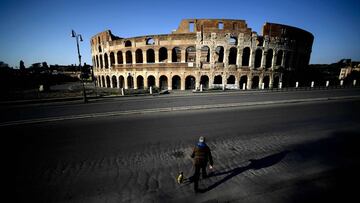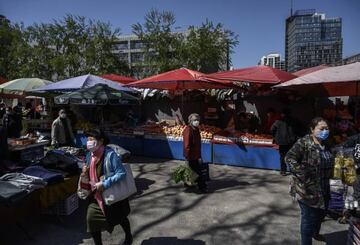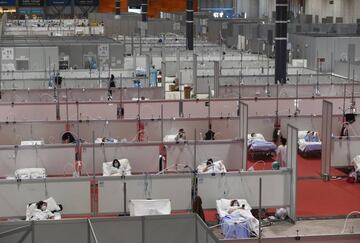Coronavirus: How many cases and deaths did China, Italy and Spain have at this time?
China, Italy and Spain quickly became the epicentres of the Coronavirus crisis and where are they now, two months down the line from the first reported case?

The coronavirus crisis was officially proclaimed a pandemic on 11 March – three weeks on, it has claimed 58,727 lives worldwide. One of the most alarming characteristics of the Covid-19 virus is that it can remain undetected for 14 days or more once a person has become infected; during that period, it is very easily spread and infection continues to grow exponentially.
So where did the coronavirus start? Which countries became the epicentres of the crisis and where are they now, weeks or months down the line? It is difficult to pinpoint who the Patient Zero was in China and who introduced the virus to Italy, Iran and Spain as like in many other parts of the northern hemisphere, when the epidemic started, it was the middle of winter and many people had been struggling with bouts of flu and the common cold.

China coronavirus timeline
The first worldwide case, according to the South China Morning Post, was reported in Wuhan, Hubei province in China on 17 November 2019. However, Chinese officials claim the first coronavirus patient fell ill on 7 December and tested positive for Covid-19 three days later. Investigations into the new coronavirus began on 26 December after more patients had been admitted to hospital with symptoms, a cough and a fever. On 30 December, an alert was posted by Wuhan medical authorities with 27 cases confirmed by the following day.
By 20 January, the number of cases had risen five-fold to 136 and there was another problem. Many Chinese workers abroad had booked flights home to see their families and celebrate Chinese New Year on 25 January. By the time most had arrived, the county was in strict lockdown – nobody was allowed to venture out of their house unless to buy essentials – food, toiletries… etc. On top of that, every citizen was tested and given a QR code to be given access to shops and supermarkets. If you were suffering symptoms, you would not be able to enter the shop. Unlike parts of Europe, everyone had to comply with the lockdown - and did - staying at home, leaving cities deserted. The larger cities like Shanghai were able to deal the influx of cases but other areas were snowed under. “In Wuhan, whole families died together, at home, because there was no room for them at the hospital,” a member of Madrid’s Chinese community (the majority of whom are from the east coast, Zhejiang province), told AS. By the end of January, according to the official figures, 11,971 cases had been confirmed with 259 deaths.
Today, 115 days since the first reported case of coronavirus infection on 10 December, China has registered 81,620 cases with 3,322 deaths. Some argue that the real figures could be much higher.

Italy coronavirus timeline
In Italy, the first reported case of coronavirus was on 18 February – a middle-aged man, with no connection to China or contact with Chinese people, tested positive in Codogno, Lombardy and was admitted to hospital two days later. The following day, Valencia’s Champions League tie against Atalanta went ahead as planned in front of a packed crowd in Milan.
By 23 February, Italy had recorded 130 new cases, 11 towns were sealed off to contain the virus and carnival in Venice had been called off. The epidemic escalated, mainly affecting the northern regions. By the end of the month, the country had 1,128 cases and 29 deaths and was taking measures to tackle the crisis but it was too late to stop the virus from being spread to other parts of Europe.
Italy’s figures today, 45 days from the first confirmed case makes stark reading – 119,827 infected with 14,681 lives lost.

Spain coronavirus timeline
Like in Italy and China, during the months of January and February, the sight of people coughing and sneezing on their way to work was a familiar one – as it is every winter. The Spanish had seen what had been happening in China and Italy but like almost everyone else, underestimated how contagious Covid-19 is and how easily it could enter the peninsula. The first reported case was in the Canary Islands on 31 January; a German tourist had been feeling unwell and was admitted to hospital in La Gomera. There was a second case recorded on 9 February in Palma, Mallorca but the first case on mainland Spain came a fortnight later – a women in Barcelona, who had recently returned from Italy went to see her doctor with symptoms. On 27 February, a sports journalist was admitted to the general hospital in Valencia suffering from flu-like symptoms, he had covered the Atalanta game in Milan just over a week earlier, and tested positive.
The first death from coronavirus in Spain was on 13 February, a 69-year-old who had recently been on a trip to Nepal died in hospital in Valencia. By the end of February, more cases were emerging in Valencia, Barcelona and the first in Madrid – in Torrejón on the outskirts of the capital. But Valencia was the focal point at the start of March – which coincided with the arrival of thousands of tourists for Las Fallas, many flying over from Italy for the celebrations. Las Fallas was cancelled on 10 March but only after the Mascletà and Pirotecnia Crespo firework displays had taken place on both of the previous two days, attracting hundreds of sightseers. And on Sunday, 8 March, 120,000 attended a march through Madrid to celebrate International Women’s Day – both of those events are likely to have contributed to the spread of coronavirus in mainland Spain.
Today in Spain, 63 days after the first reported case and 50 days after the first coronavirus-related death, 119,199 positive cases have been reported and 11,198 people have lost their lives due to the virus.





